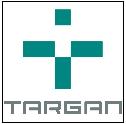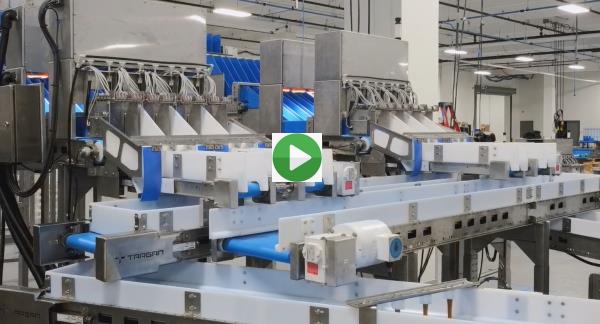 TARGAN Inc., based in Raleigh, NC, has developed the WingScan™ feather-sexing system for broiler chicks. The WingScan system comprises a multilevel conveyer system to channel chicks into a single file for passage through a machine-vision detector that can differentiate between fast and slow feathering wing plumage. The system is engineered to integrate with existing hatchery automation equipment, and will incorporate TARGAN’s individual chick vaccine delivery system in the future.
TARGAN Inc., based in Raleigh, NC, has developed the WingScan™ feather-sexing system for broiler chicks. The WingScan system comprises a multilevel conveyer system to channel chicks into a single file for passage through a machine-vision detector that can differentiate between fast and slow feathering wing plumage. The system is engineered to integrate with existing hatchery automation equipment, and will incorporate TARGAN’s individual chick vaccine delivery system in the future.
TARGAN has combined chick-handling technology developed during the 1990s with contemporary machine vision and AI. Under the direction of Ramin Karimpour, a team of engineers and bio-scientists has applied modern detection systems and electronics to produce a multi-patented commercial and practical installation to separate male and female broiler chicks.
The WingScan system is modular with each unit capable of processing up to 50,000 chicks per hour with up to 98 percent accuracy. Chicks are loaded onto the system and are successively separated into a single track by gently transiting a cascade over three conveyor levels. The system is designed to minimize chick stress and physical handling, contributing to optimum growth and livability during the first week after placement. By placing multiple 8-lane WingScan units in parallel, it is possible to increase throughput by increments of 100,000 chicks per hour to accommodate required hatchery capacity.
Click image to watch video
 |
The business model applied by TARGAN is based on an equipment-and-service royalty payment paralleling the situation with in ovo vaccinators. This is considered essential for an emerging technology since it absolves integrators from making large, initial capital investment before long-term confirmation of functionality and benefits.
It is possible to manually differentiate chick gender using feather-sexing strains. This requires a team of trained workers to handle and inspect each chick before allocation to either male or female chutes on a carousel conveyer. Although this approach was used by a small proportion of the U.S. broiler industry during the 1980s and 1990s, use was limited by the availability of workers and the incidence rate of ergonomically induced carpal tunnel syndrome.
The WingScan system completely automates sorting by gender at a cost equivalent to manual processing. WingScan has a far smaller footprint than carousels and is suitable for retrofitting to existing hatcheries. The rate of processing expedites chick handling to ensure early delivery to farms.
TARGAN provides a practical method to differentiate gender at the hatchery. Integrators derive benefits associated with lower live-bird cost and greater uniformity at processing, but only by reconfiguring placement programs and schedules to achieve desired uniformity. The potential benefits from separate gender grow-out accrue from a lower live bird cost that can be achieved from precision feeding according to the relative growth rates of male and female broilers in separate flocks. There is probably less intra-flock competition with single-gender placement and adjustment of feeder and drinker lines is simplified without compromising availability. Financial benefits can be derived through reconfiguring placement and harvesting schedules, training of contractors and service people to the realities of separate gender grow-out including feeding programs and post placement vaccination. Separation of male and female chicks at the hatchery does not necessarily guarantee a financial return, but provides the basis for integrators to realize significant financial return through changes to existing straight-run grow-out.
TARGAN has developed an alliance with a major integrator allowing field evaluation of both the operational aspects and financial benefits. This integrator produces a range of heavy broilers for portioning, conventional weights for whole-bird sales and small birds with a narrow weight range for QSR-portioning. Clearly, separate-gender grow-out will have benefits at the two extremes of live weight both with respect to live bird production and processing.
TARGAN will have a receptive market in Brazil given the structure and export orientation of that industry. Importers in Middle Eastern nations require a narrow range of carcass weights within predetermined fixed-weight categories for bagged birds ranging from 900g to 1,300g. usually in 100g increments.
Although male and female chicks are placed separately with an anticipation of standard growth rate for a strain, biological factors including variability in nutrient quality, climatic extremes and disease challenge may result in deviation from standard daily gain. This requires fine-tuning of predicted harvest age to attain a predetermined live weight and uniformity. A complementary technology to WingScan™ would be a machine-vision system to determine average bird weight in real-time based on continuous scanning of the flock. Portable units could be placed in grow-out houses within two weeks of harvest to monitor weight and daily gain to optimize the uniformity of flocks delivered to the processing plant.
TARGAN has developed a practical method of separating male and female broiler chicks using its patented WingScan system. Financial benefits to integrators will accrue only if they apply appropriate flock management, nutrition and scheduling of chick placement and harvest.